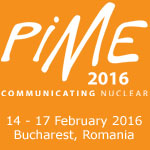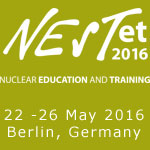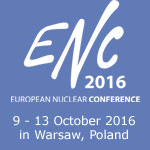
ENS NEWS N°50: EditorialThe past few months were characterised by a rush to finalise 2015 and not leave anything unfinished. The organised and orderly start to 2016 shows that we did a good job with this task. At the European Nuclear Society, we find ourselves between two very important events in history: the up-coming celebration of the 40th anniversary of ENS in Amsterdam in April and the COP21 climate change conference which took place in Paris in December. To mark the 40th anniversary, ENS is organising a special event to be held in Amsterdam on 6 and 7 April 2016 in cooperation with the Dutch presidency of the Council of the EU. Now that the Society moves into its forties, it is an opportunity to take a look at how far nuclear technology has come and to peer into the future of the various applications from which we benefit. After all, leading-edge nuclear technologies lead to innovative industrial applications, improve quality of life and create new markets. For example, Europe is a major player in research and development of nuclear medicine. We have been using nuclear technology for medical applications for nearly a century. Globally, eight reactors (five of which in the EU) provide the radio-isotopes used for medical and radiation therapy purposes. Nuclear technology is also widely used for industrial applications. One example which is increasingly becoming more important is the production of neutron-doped silicon used in solar pv panels, wind turbines and high-speed trains, among others. Renewable energy generation sources are becoming more widespread all over the world but the manufacturing of these installations would be impossible without nuclear technology. Let us not forget that we would also be unable to continue with our exploration of the deepest reaches of space without nuclear power sources. The Mars rover Curiosity, which has become famous world-wide with its staggering photos from the Red Planet, is powered by a perpetual nuclear power source. Several other probes, such as Voyager, have reached the edges of our Solar System only because of nuclear energy sources. To develop this technology, the global nuclear industry has had to cooperate. The continuous development of nuclear technology has taken us from the targeted destruction of infected cells in our bodies to the farthest reaches of the galaxy. With continued cooperation, only time will tell what human-kind can achieve! At the same time, we should not forget that nuclear power has a large role to play in the sustainable development of the human environment. An historic agreement to combat climate change and unleash actions and investment towards a low carbon, resilient and sustainable future was agreed by the 195 nations present in Paris in December 2015. Its main aim is to keep a global temperature rise this century “well below 2 degrees Celsius” and to drive efforts to limit the temperature increase even further to 1.5 degrees Celsius above pre-industrial levels. According to the latest scientific reports, global temperatures have already risen by almost 1 degree Celsius. The Paris Agreement and the outcomes of the UN climate conference (COP21) cover all the crucial areas identified as essential for a landmark conclusion. As well as setting a long-term direction, countries will peak their emissions as soon as possible and continue to submit national climate action plans that detail their future objectives to address climate change. This builds on the momentum of the unprecedented effort which has so far seen 188 countries contribute climate action plans to the new agreement, which will dramatically slow the pace of global greenhouse gas emissions. In fact, two contributions were submitted the day the Agreement was adopted. During COP21, the Nuclear for Climate initiative was present in both the Gallery of Solutions and the so-called Blue Zone, where negotiations took place. The booth at the Gallery organised several events with nuclear experts and pro-nuclear environmentalists to inform attendees of the benefits of using nuclear energy as part of the solution to fighting climate change. Also present in the Blue Zone were two international organisations on nuclear energy: the International Atomic Energy Agency (officially a UN organisation) and the OECD Nuclear Energy Agency (OECD/NEA). They organised three side-events during COP21 which attracted the attention of many journalists and participants from different backgrounds. The side-events focused on the need to adapt energy infrastructure to the effects of climate change, especially related to the large requirement for cooling water for nuclear power plants. The presentations also included scientific studies showing the importance of nuclear energy for tackling climate change and reducing greenhouse gas emissions. ENS will continue to support the Nuclear for Climate initiative in preparation for COP22 which will take place in Marrakech, Morocco, from 7 to 18 November 2016. The initiative will build on its successes in Paris and will try to raise further awareness of the benefits to use nuclear power as a low carbon energy technology. Happy New Year 2016! Lubomir Mitev
|
Word from the PresidentThe future of ENS will now focus on the up-coming celebration of the 40th anniversary of the Society. The focus will be on nuclear technology bringing innovation to our lives well beyond its simple energy generation applications. While we focused so much on this aspect during the COP 21 conference, the 40th anniversary event will shine the spotlight on the other aspects of nuclear: medicine, industry and space among others. |
PIME 2016 – Getting ready for the PIME Award!14 - 17 February 2016, Bucharest, Romania The PIME Award candidates for 2016 have already been shortlisted and include several outstanding innovative communications campaigns. |
RRFM/IGORR 2016 – Programme out now !13 - 17 March 2016, Berlin, Germany This year RRFM, the European Research Reactor Conference, will be jointly organised with IGORR, the International Group Operating Research Reactors. |
NESTet 2016 : a focus on excellence in project management22 -26 May, Berlin, Germany We are different ! Are we different?Efficient project management is crucial for success - and yet projects fail to be delivered on time and within budget. |
The European Forum to discuss Nuclear Science & Technology Issues, Opportunities & Challenges9 - 13 October 2016, Warsaw, Poland Young Generation – don’t miss out on ENC 2016!The European Nuclear Conference (ENC) is THE bi-annual get-together of nuclear professionals from all over Europe and the world and ENC 2016 will offer a range of attractive opportunities for young professionals. T |



